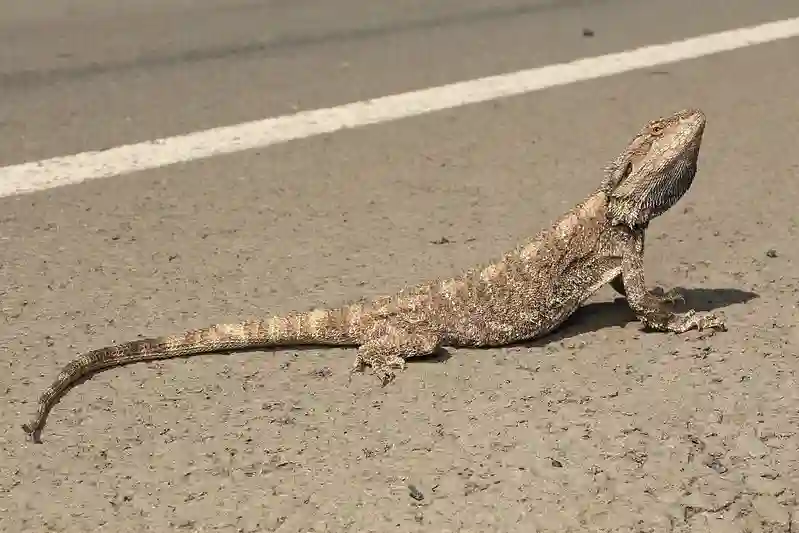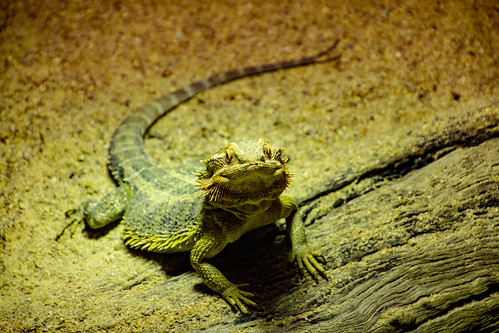Yes, bearded dragons’ tails can change color for various reasons, including growth, shedding, temperature changes, and mood.
The tail usually turns white when it sheds, which is the most noticeable time for color changes.
Also, bearded dragons can change the color of different parts of their bodies independently.
As an example, dark backs and tails can be caused by their environment, since dark dorsal sides will reflect less light, absorbing more heat.
Reasons for Tail Color Change
Bearded dragons are fascinating creatures that can change color due to various reasons. One of the most noticeable areas where color changes can occur is on their tails. There are several reasons why bearded dragon tail colors may change, including shedding, stress, and age.
Shedding
Like all reptiles, bearded dragons shed their skin periodically as they grow. During the shedding process, the old skin will slough off, revealing a brighter and more colorful new layer underneath.
This process can cause temporary changes in coloration on the tail of a bearded dragon. The shedding process usually lasts a few days or even up to two weeks.
During this time, you may notice that your bearded dragon’s tail appears duller or less vibrant than usual. This is because the old skin is starting to come off and has not yet been fully shed.
Stress
Sometimes a bearded dragon’s tail color can change due to stress. Bearded dragons are sensitive animals that can become stressed easily if they don’t feel comfortable or secure in their environment. Stressful situations such as overcrowding or inadequate basking temperatures may cause temporary color changes in their tails.
If your bearded dragon’s tail has changed color due to stress, it may appear darker than usual or even black in some cases. You may also notice your beardie acting lethargic or exhibiting other signs of stress such as loss of appetite or hiding away from its surroundings.
Age
The age of a bearded dragon can also affect its tail coloration over time. As they grow older, some beardies’ tails may start to darken and become more prominent compared to when they were younger.
Older bearded dragons may also develop blemishes or spots on their tails as a result of aging. These age-related changes are perfectly normal and nothing to be concerned about unless they’re accompanied by other symptoms.
Understanding the reasons why your bearded dragon’s tail color may change is essential for keeping it healthy and happy. By monitoring your pet’s behavior and environment, you can help prevent stress-related color changes while ensuring that any issues with shedding or other age-related changes are addressed in a timely manner.
How to Care for Your Bearded Dragon’s Tail?
Caring for your bearded dragon’s tail is important to ensure its health and well-being. Here are some steps you can take to care for your bearded dragon’s tail:
- Identify and treat tail rot: Tail rot is a common condition in bearded dragons that requires immediate attention. If you notice any signs of tail rot, such as the tail turning black, becoming dry and brittle, or lack of blood flow, it is important to contact a veterinarian as soon as possible. They can provide the necessary treatment, which may include antibiotics and other medications.
- Clean the tail: Regularly cleaning your bearded dragon’s tail is essential for maintaining its hygiene. You can wash the tail with lukewarm water every day to keep it clean.
- Soak the tail: Soaking the tail in warm water and a solution of Betadine (iodine) can help prevent infection and promote healing. Here’s how you can do it:
- Mix one part Betadine with three parts warm water to create a solution that resembles dark tea.
- Immerse the infected part of the tail completely in the mixture and let it soak for about 5 minutes.
- After soaking, gently dry the tail with clean paper towels or cotton.
- Apply ointment: After drying the tail, you can apply a thin layer of Neosporin or another reptile-safe antiseptic ointment to the affected area.
- Monitor for improvement: Keep a close eye on the tail to ensure that the rot isn’t spreading to the rest of the body. If you don’t see any improvement after a week or if the infection continues to spread, it is important to consult a veterinarian for further treatment.
Remember, if you notice any signs of tail rot or other health issues, it is always best to consult a veterinarian for proper diagnosis and treatment.
Tips on How to Maintain Your Beardies’ Tail Health
Here are some tips on how to maintain your bearded dragon’s tail health:
- Proper Nutrition: A healthy diet helps boost the immune system and prevents health conditions like tail rot. The diet should be high in calcium and vitamins. Bearded dragons are omnivorous, so they should eat vegetables, fruit, and insects. At the same time, they should also have supplements, and food should be dusted with calcium powder.
- UVB Lighting: UVB lighting is of utmost importance to day-active lizards like bearded dragons, and they should receive 12 hours a day. This helps their bodies metabolize calcium and keeps their bones strong and healthy.
- Housing: Try not to house babies together. These early life stages are when potential injuries can happen that can eventually lead to tail rot. They are known for biting each other’s tails and toes. Housing adults together can be just as dicey. Though some beardies can get along, it doesn’t mean they will forever.
- Proper Hygiene: Clean all surfaces like food bowls and decor, also, take a look at the plants. Plants should be trimmed or replaced every once in a while.
- Handling: During handling, always be gentle and do not squish its tail. Always handle your bearded dragon near a solid surface so you have an area to put it down when you need to. As we do not want our beardies to fall to the ground, we try to hold them firmly in place as we try to find a safe spot to lay them down. In the process, the tail can get trapped on our arms or hands, which restricts blood flow. If we are not mindful, we might have caused a slight kink to the tail unknowingly. Further, if you have children and they also play with your beardie, it is possible that they tightly tied something on its tail, like a rubber band or a hair tie.
- Clean the tail daily in lukewarm water to free it from any debris. Use paper towels as a substrate when possible.
- Betadine: The best way to treat tail rot in bearded dragons is with Betadine. Betadine is an antiseptic that can fight off infection and help restore your beardie’s tail health.
If you suspect that your bearded dragon has tail rot, it’s best to take them to a reptile veterinarian for treatment.
What to Do If You Notice Any Abnormalities in Your Beardies’ Tail?
If you notice any abnormalities in your bearded dragon’s tail, it is important to take action to ensure your pet’s health. Here are some steps you can take:
- Observe your bearded dragon’s behavior: Unusual behaviors in bearded dragons are usually signs of distress or sickness. If your bearded dragon is showing signs of discomfort, such as gaping its mouth often or having a dark beard and/or tail tip for an extended period of time, it is time to talk to your vet about options.
- Check for tail rot: If your bearded dragon’s tail is crooked, it may be a sign of tail rot, which can become fatal if left untreated. This condition can be treated with antibiotics, proper nutrition, and improved husbandry.
- Look for signs of metabolic bone disease: This is a common disease in bearded dragons that can cause deformities in the tail and other bones. Symptoms include lethargy, lack of appetite, and difficulty moving. Contact your vet as soon as you notice any symptoms, however mild.
- Take your bearded dragon to the vet: If you notice any abnormalities in your bearded dragon’s tail, it is important to take your pet to the vet for a physical examination, blood testing, radiographs (X-rays), and, if necessary, an ultrasound examination. Your vet can diagnose the problem and recommend appropriate treatment.
Conclusion
After reading this article, it should be apparent that the tail color of a bearded dragon can change due to various factors. Shedding, stress, and age are all factors that can affect the coloration on a beardie’s tail.
It is essential to understand these causes so you can react accordingly as an owner. Monitoring your pet’s health and tail color is vital in keeping them healthy and happy.
There are several species/subspecies of bearded dragons, and each one may have slightly different colored tails. Understanding this fact can help you identify which species/subspecies you have and what type of care they require.
Over time, a bearded dragon’s tail will continue to change color as they grow older. The changes in tail color may not necessarily indicate any health problems; however, it is still important to monitor any significant changes.
It is also crucial to take care of your bearded dragon’s tail properly by providing them with the right food, hydration, environment, and exercise. Maintaining their tails’ health will ensure their overall well-being.
Final Thoughts: Why Understanding Tail Changes Is Important
Understanding why a bearded dragon’s tail changes color is vital as an owner because it allows us to spot any abnormalities or signs of stress or illness early on. By noticing these signs early on, we can react quickly and avoid potential health problems down the road.
Additionally, understanding how different species/subspecies may have different colored tails helps us understand our pets better by identifying their specific needs for proper care.
Overall, owning a bearded dragon requires dedication and commitment just like any other pet. Understanding their physiology and behavior is crucial in maintaining their health and happiness for many years to come.


